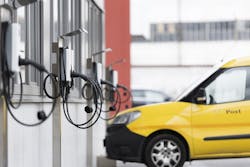Environmental sustainability and decarbonization initiatives have become high priorities for equipment executives in the board rooms of organizations across the nation and around the world. One of the leading topics within these discussions is the electrification of equipment utilized within their operations. Progressive organizations large and small are beginning to explore how transitioning equipment to electrification can benefit their companies’ bottom lines. In response, equipment manufacturers and equipment organizations have increased attention and momentum to the electrification of construction equipment.
For decades, equipment managers have emphasized the reduction of fuel consumption as a primary goal of their strategies, with the benefit being an operational cost reduction. Recently, a worldwide emphasis upon environmental sustainability, increasing governmental regulations and mandates, and the accelerating cost of fuel itself are propelling interest and growth in the electrification of equipment. Rising fuel costs have been cited by equipment executives as the No. 1 source of higher operational costs as fuel prices have continued their steady rise in 2020 and 2021 and into 2022 with no relief in sight.
Benefits of electric construction equipment
The benefits of equipment electrification include reduced carbon and greenhouse gas emissions; reduced cost; and smoother, quieter operation. Advances in technology over the past decade have enabled manufacturers of electrification components and OEMs to produce electrified equipment with performance capabilities that rival that of various types of equipment powered by internal combustion engines (ICE). The move to electrify heavy-duty equipment increases the potential for long-term operational cost savings due to reduced maintenance—there are fewer moving parts—and a steady reduction in fuel consumption. Understanding these potential benefits, progressive organizations have begun exploring how electric solutions could fit into their operations.
Electrification of heavy-duty construction equipment is poised to benefit from the advances made in the electrification of on-road vehicles over the past decade. The evolution of computerized battery-management technology and the batteries themselves have advanced significantly, allowing for increased operational parameters and reduced recharging times. Electric-drive motors have developed from standard centralized configurations to direct-drive axle integration, making them easily adaptable to equipment final drives. These technologies and others will be significant in the advancement of electric drives and componentry for heavier construction equipment.
It is possible that electric-powered equipment may eventually become the primary power source for equipment utilized within the construction industry, although there are many challenges yet to overcome.
Current and extremely challenging barriers to electrification are significant. Some of the more difficult challenges are increased capital cost, limited duty cycles, charging infrastructure challenges at worksites or maintenance facilities, and restrictive or limited product availability. Sheer battery size requirements for larger equipment are also restrictive to rapid implementation.
Challenges to electrification
Other areas of significant concern are infrastructure challenges for manufacturing and recharging battery-powered equipment and the increased manufacturing capabilities required to meet the anticipated future demand of larger equipment types. Increased supply of raw minerals and materials required to meet the demand for additional battery development, as well as the electrical componentry required to manage and control these systems, is another area restricting product availability. Over the past decade, considerable advancement in battery technology required for increasing the proliferation of electric equipment in use within the industry have transpired. The application, however, is mostly limited to smaller, site-specific types of equipment and on-road vehicles and trucks.
To meet increased sustainability goals, many organizations have already developed and implemented an environmental plan that includes a transition to electric equipment, usually over a defined period well into the future. Organizations that are just beginning to explore electrification initiatives should consider development of a plan that includes, but is not limited to, the following points:
Establish the organization’s goals. Understand the driving factors of the initiative. Internally, is there widespread leadership consensus and specific carbon-reduction targets? Externally, is the initiative driven by regulations or mandates having specific carbon-reduction quantities or timelines included within them? Is a partnership or merger with other organizations on a specific project having carbon requirements a factor?
Define equipment types. Which types should be included in the initiative and what will be the phase-in timeline? Battery-electric equipment is not currently readily available across product lines of most manufacturers and may not be the best alternative for the requirement. What are the duty cycles and performance requirements, and will these change over the life cycle of the equipment? Can the organization’s initiative begin with on-road vehicles and trucks and smaller site equipment currently available with future expansion as availability increases?
Identify charging infrastructure improvements. What are the charging requirements of the equipment targeted within the plan, and who will develop the infrastructure to meet these requirements? Will electrical service upgrades be required at existing facilities to facilitate these additional charging loads? Will the equipment be available to recharge during off-peak charging rate cost periods? Are there solar-powered charging systems available for remote sites or to offset charging costs?
Train field teams and support staff. Prior to implementation, all personnel involved with the operation of the equipment and infrastructure will require specific electrical equipment training. The operating and maintenance characteristics for electrified equipment are different then ICE-powered equipment. Are policies updated to include electric-powered equipment operation and maintenance? Are there electrified rentals available for testing, training, and baseline performance establishment?
Validate performance and update goals. Clarify how the organization will measure the performance and outcome of their electrification initiative. This requires organizations to base initial expectations upon OEM-supplied data and calculated assumptions. Terrain, duty cycle, and even operators are all variable. Real-world information once the electrified equipment has been deployed must be captured quickly. Organizations should monitor this equipment’s performance and cost, adjusting goals and baseline assumptions carefully.
Equipment electrification is quickly becoming an important part of the environmental sustainability strategy for equipment fleets. A sustained organization-wide effort, dedicated time, significant investment, and incremental steps over time will enable organizations to transition to electrification. The time to begin planning for equipment electrification is now.
About the Author

Mike Brennan, CEM
Michael Brennan is a 40-plus-year industry veteran and consultant in vehicle and equipment maintenance management. A three-time recipient of the AEMP Fleet Masters Award, he focuses upon process improvement, facilities management, succession planning, technology, and lifecycle analytics as the cornerstone of success in the equipment management industry.
Read Mike's asset management articles.
